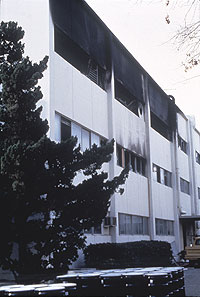
After the Disaster: Lessons
Learned from Cal State Northridge by Valerie Orleans In the predawn hours of Jan. 17, 1994, a 6.7 earthquake struck Southern California; its epicenter was three short miles from Cal State Northridge. At that time, Bruce Erickson, CSUF's associate vice president of university communications and marketing, was public relations director for the Northridge campus.
"There was major structural damage to several buildings on campus," Erickson recently recalled. "The earthquake damaged every one of our major buildings. One new parking structure totally collapsed. There were fires in the science building and several more fires in our neighborhood around the campus. An apartment building that housed dozens of faculty and students collapsed, causing 16 deaths and dozens of injuries." Fortunately, because of the early hour — and a university holiday — few people were on campus when the earthquake struck. Because of the extensive damage suffered, however, recovery would last for years. Fires in the science building created an immediate problem: the release of potentially hazardous materials from research experiments literally going up in smoke. Additionally, faculty members wanted to enter unstable buildings to retrieve computers, artwork, important documents and tests related to their research. "I understood their concerns," Erickson
said. "For
many of them, their research was their life's work. But the
simple fact was, the buildings were unsafe and, as a result, fire
marshals and building inspectors could not allow them to enter." "It was frustrating to watch all that work burning," Erickson said. "There were professors literally crying when the enormity of the situation began to sink in. At a certain point for some, a sense of overwhelming hopelessness set in." | next » |


 Produced by the Office of Public Affairs at California State University, Fullerton.
Contact the
Produced by the Office of Public Affairs at California State University, Fullerton.
Contact the